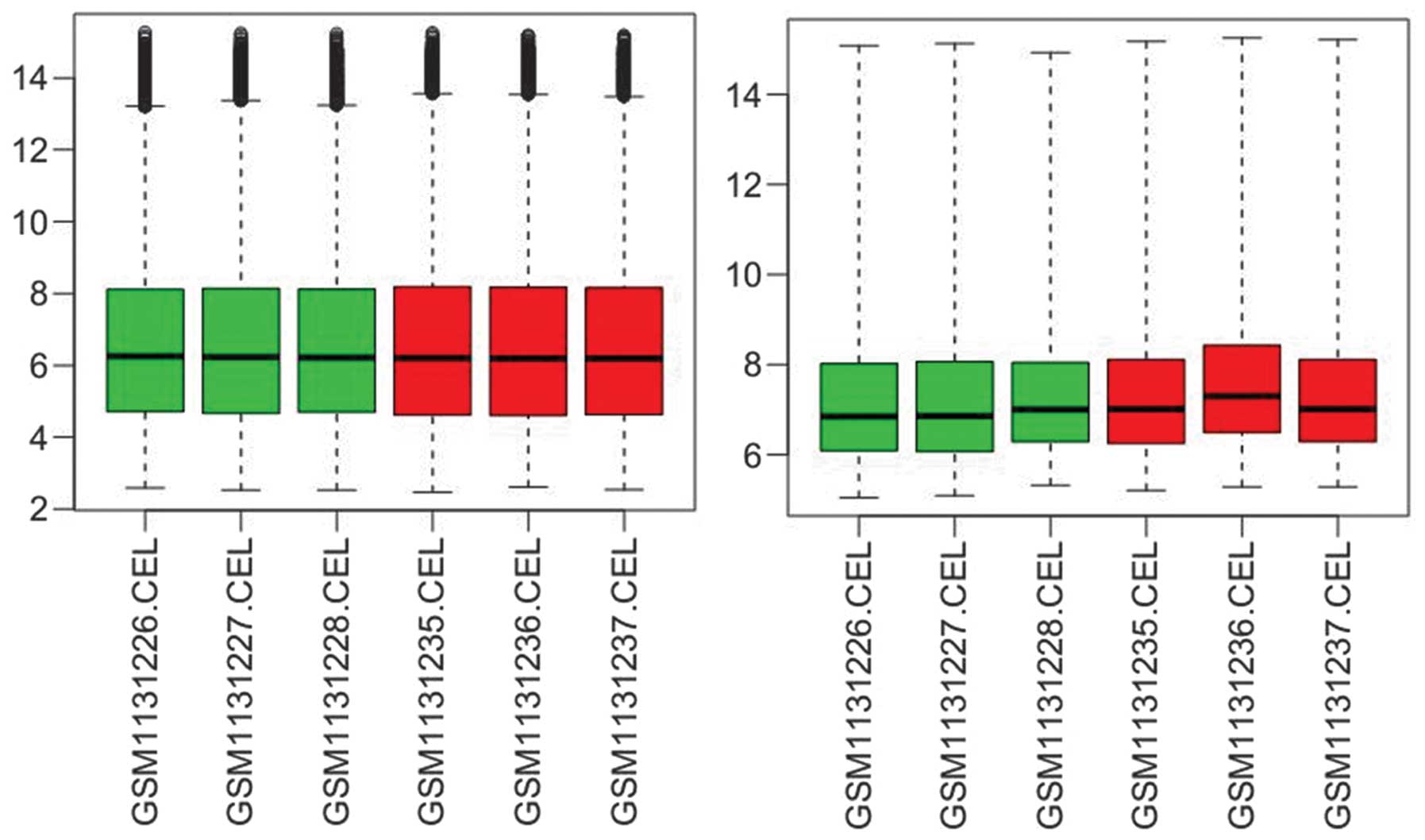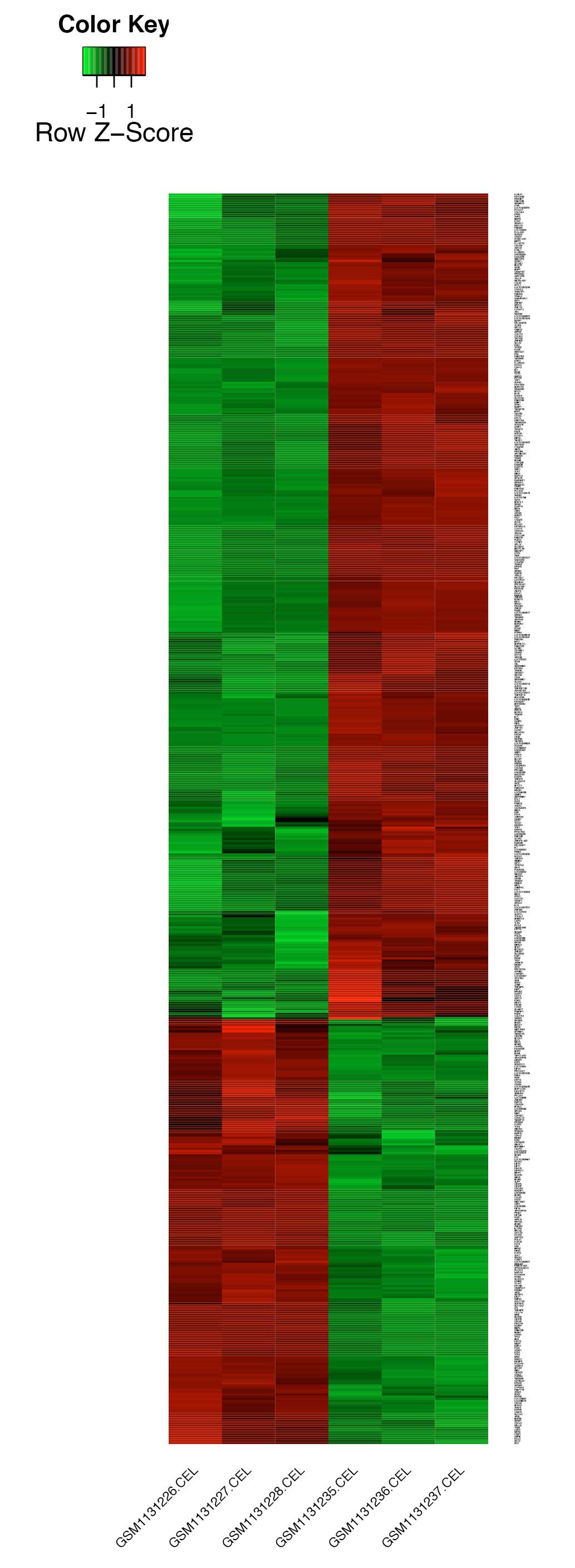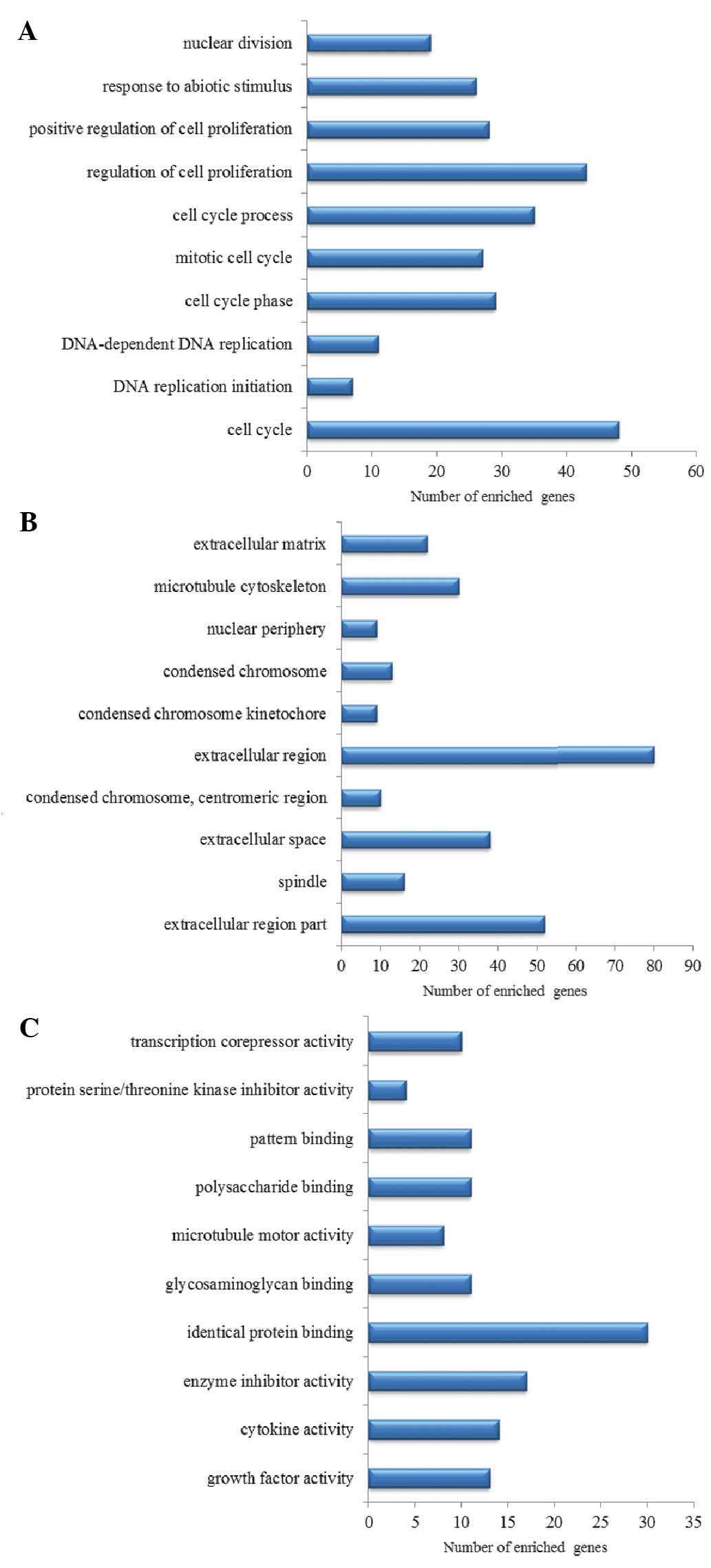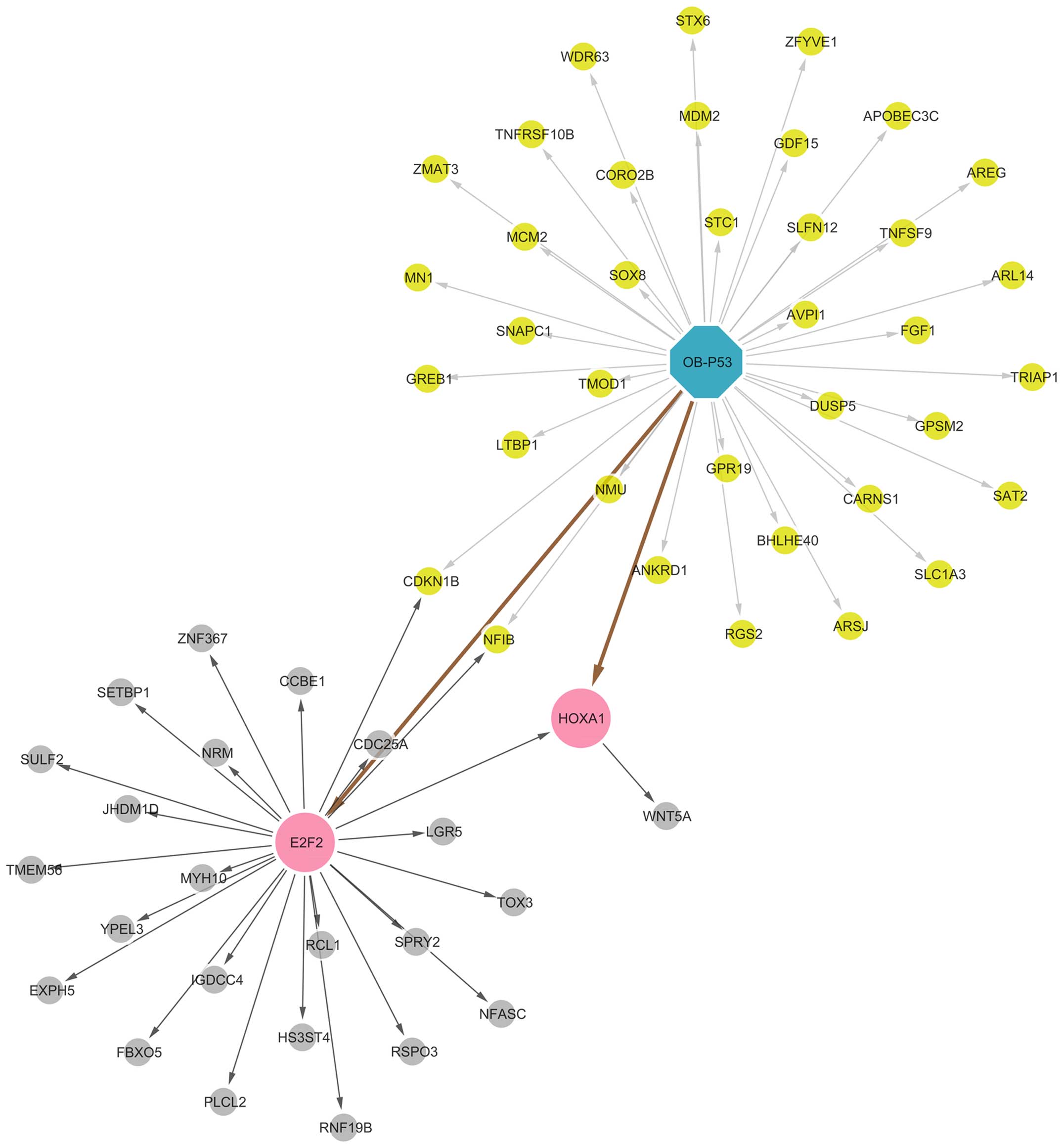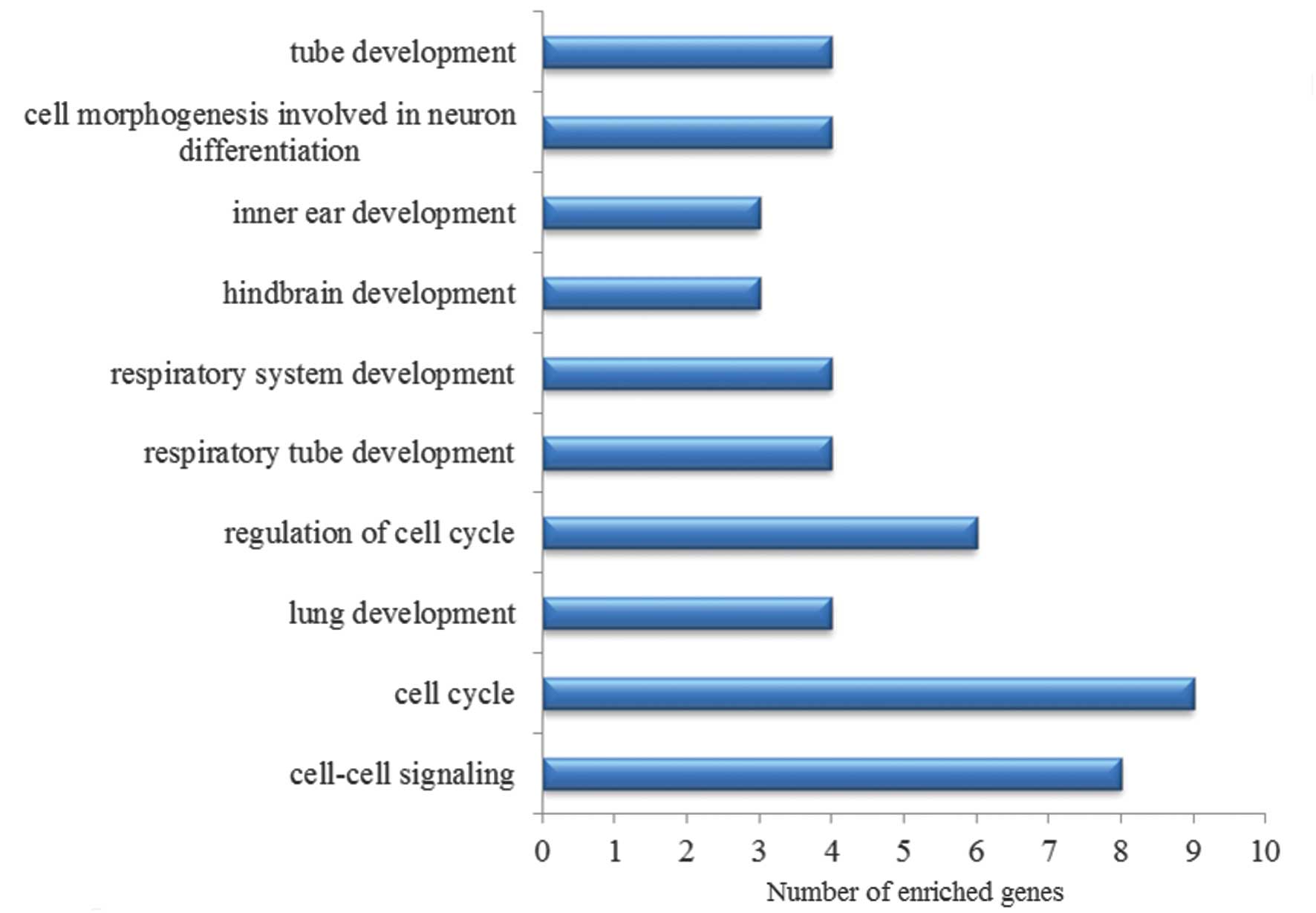|
1
|
Espinosa JM: Mechanisms of regulatory
diversity within the p53 transcriptional network. Oncogene.
27:4013–4023. 2008. View Article : Google Scholar : PubMed/NCBI
|
|
2
|
Menendez D, Inga A and Resnick MA: The
expanding universe of p53 targets. Nat Rev Cancer. 9:724–737. 2009.
View Article : Google Scholar : PubMed/NCBI
|
|
3
|
Riley T, Sontag E, Chen P and Levine A:
Transcriptional control of human p53-regulated genes. Nat Rev Mol
Cell Biol. 9:402–412. 2008. View
Article : Google Scholar : PubMed/NCBI
|
|
4
|
Miller LD, Smeds J, George J, Vega VB,
Vergara L, Ploner A, Pawitan Y, Hall P, Klaar S, Liu ET and Bergh
J: An expression signature for p53 status in human breast cancer
predicts mutation status, transcriptional effects and patient
survival. Proc Natl Acad Sci USA. 102:13550–13555. 2005. View Article : Google Scholar
|
|
5
|
Wei CL, Wu Q, Vega VB, Chiu KP, Ng P,
Zhang T, Shahab A, Yong HC, Fu Y, Weng Z, et al: A global map of
p53 transcription-factor binding sites in the human genome. Cell.
124:207–219. 2006. View Article : Google Scholar : PubMed/NCBI
|
|
6
|
Bruna A, Darken RS, Rojo F, Ocaña A,
Peñuelas S, Arias A, Paris R, Tortosa A, Mora J, Baselga J and
Seoane J: High TGFβ-Smad activity confers poor prognosis in glioma
patients and promotes cell proliferation depending on the
methylation of the PDGF-B gene. Cancer Cell. 11:147–160. 2007.
View Article : Google Scholar : PubMed/NCBI
|
|
7
|
Rozan L and El-Deiry W: p53 downstream
target genes and tumor suppression: A classical view in evolution.
Cell Death Differ. 14:3–9. 2006. View Article : Google Scholar : PubMed/NCBI
|
|
8
|
Botcheva K, McCorkle SR, McCombie W, Dunn
JJ and Anderson CW: Distinct p53 genomic binding patterns in normal
and cancer-derived human cells. Cell Cycle. 10:4237–4249. 2011.
View Article : Google Scholar : PubMed/NCBI
|
|
9
|
Smeenk L, Van Heeringen SJ, Köppel M,
Gilbert B, Janssen-Megens E, Stunnenberg HG and Lohrum M: Role of
p53 serine 46 in p53 target gene regulation. PloS One.
6:e175742011. View Article : Google Scholar : PubMed/NCBI
|
|
10
|
Smeenk L, van Heeringen SJ, Koeppel M, van
Driel MA, Bartels SJ, Akkers RC, Denissov S, Stunnenberg HG and
Lohrum M: Characterization of genome-wide p53-binding sites upon
stress response. Nucleic Acids Res. 36:3639–3654. 2008. View Article : Google Scholar : PubMed/NCBI
|
|
11
|
Jaffe N, Bruland OS and Bielack S:
Pediatric and adolescent osteosarcoma. Springer; New York, NY: pp.
275–287. 2010
|
|
12
|
Ottaviani G and Jaffe N: The epidemiology
of osteosarcoma. Cancer Treat Res. 3–13. 2010.PubMed/NCBI
|
|
13
|
Menendez D, Nguyen TA, Freudenberg JM,
Mathew VJ, Anderson CW, Jothi R and Resnick MA: Diverse stresses
dramatically alter genome-wide p53 binding and transactivation
landscape in human cancer cells. Nucleic Acids Res. 41:7286–7301.
2013. View Article : Google Scholar : PubMed/NCBI
|
|
14
|
Gautier L, Cope L, Bolstad BM and Irizarry
RA: Affy-analysis of Affymetrix GeneChip data at the probe level.
Bioinformatics. 20:307–315. 2004. View Article : Google Scholar : PubMed/NCBI
|
|
15
|
Diboun I, Wernisch L, Orengo CA and
Koltzenburg M: Microarray analysis after RNA amplification can
detect pronounced differences in gene expression using limma. BMC
Genomics. 7:2522006. View Article : Google Scholar : PubMed/NCBI
|
|
16
|
Qin J, Li MJ, Wang P, Zhang MQ and Wang J:
ChIP-Array: combinatory analysis of ChIP-seq/chip and microarray
gene expression data to discover direct/indirect targets of a
transcription factor. Nucleic Acids Res. 39:W430–W436. 2011.
View Article : Google Scholar : PubMed/NCBI
|
|
17
|
Huang DW, Sherman BT, Tan Q, Collins JR,
Alvord WG, Roayaei J, Stephens R, Baseler MW, Lane HC and Lempicki
RA: The DAVID Gene Functional Classification Tool: A novel
biological module-centric algorithm to functionally analyze large
gene lists. Genome Biol. 8:R1832007. View Article : Google Scholar : PubMed/NCBI
|
|
18
|
Diller L, Kassel J, Nelson CE, Gryka MA,
Litwak G, Gebhardt M, Bressac B, Ozturk M, Baker SJ and Vogelstein
B: p53 functions as a cell cycle control protein in osteosarcomas.
Mol Cell Biol. 10:5772–5781. 1990.PubMed/NCBI
|
|
19
|
Overholtzer M, Rao PH, Favis R, Lu XY,
Elowitz MB, Barany F, Ladanyi M, Gorlick R and Levine AJ: The
presence of p53 mutations in human osteosarcomas correlates with
high levels of genomic instability. Proc Natl Acad Sci USA.
100:11547–11552. 2003. View Article : Google Scholar : PubMed/NCBI
|
|
20
|
Berman SD, Calo E, Landman AS, Danielian
PS, Miller ES, West JC, Fonhoue BD, Caron A, Bronson R, Bouxsein
ML, et al: Metastatic osteosarcoma induced by inactivation of Rb
and p53 in the osteoblast lineage. Proc Natl Acad Sci USA.
105:11851–11856. 2008. View Article : Google Scholar : PubMed/NCBI
|
|
21
|
Nakase M, Inui M, Okumura K, Kamei T,
Nakamura S and Tagawa T: p53 gene therapy of human osteosarcoma
using a transferrin-modified cationic liposome. Mol Cancer Ther.
4:625–631. 2005. View Article : Google Scholar : PubMed/NCBI
|
|
22
|
Momand J, Wu H-H and Dasgupta G:
MDM2-master regulator of the p53 tumor suppressor protein. Gene.
242:15–29. 2000. View Article : Google Scholar : PubMed/NCBI
|
|
23
|
Chène P: Inhibiting the p53-MDM2
interaction: An important target for cancer therapy. Nat Rev
Cancer. 3:102–109. 2003. View
Article : Google Scholar : PubMed/NCBI
|
|
24
|
Klein C and Vassilev LT: Targeting the
p53-MDM2 interaction to treat cancer. Br J Cancer. 91:1415–1419.
2004.PubMed/NCBI
|
|
25
|
Zhang Y, Shu L and Chen X: Syntaxin 6, a
regulator of the protein trafficking machinery and a target of the
p53 family, is required for cell adhesion and survival. J Biol
Chem. 283:30689–30698. 2008. View Article : Google Scholar : PubMed/NCBI
|
|
26
|
Bouleau S, Grimal H, Rincheval V, Godefroy
N, Mignotte B, Vayssière JL and Renaud F: FGF1 inhibits
p53-dependent apoptosis and cell cycle arrest via an intracrine
pathway. Oncogene. 24:7839–7849. 2005. View Article : Google Scholar : PubMed/NCBI
|
|
27
|
Sutton AL, Zhang X, Ellison TI and
MacDonald PN: The 1, 25 (OH) 2D3-regulated transcription factor MN1
stimulates vitamin D receptor-mediated transcription and inhibits
osteoblastic cell proliferation. Mol Endocrinol. 19:2234–2244.
2005. View Article : Google Scholar : PubMed/NCBI
|
|
28
|
Zhang X, Dowd DR, Moore MC, Kranenburg TA,
Meester-Smoor MA, Zwarthoff EC and MacDonald PN: Meningioma 1 is
required for appropriate osteoblast proliferation, motility,
differentiation and function. J Biol Chem. 284:18174–18183. 2009.
View Article : Google Scholar : PubMed/NCBI
|
|
29
|
Zhu JW, Field SJ, Gore L, Thompson M, Yang
H, Fujiwara Y, Cardiff RD, Greenberg M, Orkin SH and DeGregori J:
E2F1 and E2F2 determine thresholds for antigen-induced T-cell
proliferation and suppress tumorigenesis. Mol Cell Biol.
21:8547–8564. 2001. View Article : Google Scholar : PubMed/NCBI
|
|
30
|
Pusapati RV, Weaks RL, Rounbehler RJ,
McArthur MJ and Johnson DG: E2F2 suppresses Myc-induced
proliferation and tumorigenesis. Mol Carcinog. 49:152–156.
2010.
|
|
31
|
Laresgoiti U, Apraiz A, Olea M, Mitxelena
J, Osinalde N, Rodriguez JA, Fullaondo A and Zubiaga AM: E2F2 and
CREB cooperatively regulate transcriptional activity of cell cycle
genes. Nucleic Acids Res. 41:10185–10198. 2013. View Article : Google Scholar : PubMed/NCBI
|
|
32
|
Mohankumar KM, Xu X, Zhu T, Kannan N,
Miller LD, Liu ET, Gluckman PD, Sukumar S, Emerald BS and Lobie PE:
HOXA1-stimulated oncogenicity is mediated by selective upregulation
of components of the p44/42 MAP kinase pathway in human mammary
carcinoma cells. Oncogene. 26:3998–4008. 2007. View Article : Google Scholar : PubMed/NCBI
|
|
33
|
Bitu CC, Destro MF, Carrera M, da Silva
SD, Graner E, Kowalski LP, Soares FA and Coletta RD: HOXA1 is
overexpressed in oral squamous cell carcinomas and its expression
is correlated with poor prognosis. BMC cancer. 12:1462012.
View Article : Google Scholar : PubMed/NCBI
|
|
34
|
Enomoto M, Hayakawa S, Itsukushima S, Ren
DY, Matsuo M, Tamada K, Oneyama C, Okada M, Takumi T, Nishita M, et
al: Autonomous regulation of osteosarcoma cell invasiveness by
Wnt5a/Ror2 signaling. Oncogene. 28:3197–3208. 2009. View Article : Google Scholar : PubMed/NCBI
|



